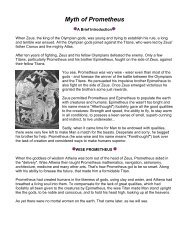Create successful ePaper yourself
Turn your PDF publications into a flip-book with our unique Google optimized e-Paper software.
African Americans During <strong>World</strong> <strong>War</strong> <strong>II</strong><br />
African Americans' response to the outbreak of <strong>World</strong> <strong>War</strong> <strong>II</strong> was ambivalent. Unlike in <strong>World</strong> <strong>War</strong> I, when African-<br />
American leader W.E.B. Du Bois had urged his people to set aside their grievances and rally to the war effort, the African-<br />
American leadership supported fighting <strong>World</strong> <strong>War</strong> <strong>II</strong> on two fronts: "victory over our enemies at home and victory over our<br />
enemies on the battlefields abroad." One African-American newspaper declared, "Our war is not against Hitler in Europe<br />
but against the Hitler’s in America." After the attack on Pearl Harbor in 1941, an African-American sharecropper reportedly<br />
told his landlord, "By the way, Captain, I hear the laps done declared war on you white folks."<br />
African Americans fought this dual fight both on the home front and in the military, with some success. The increase in<br />
war production provided good jobs for African Americans. Around two million worked in aircraft factories, steel mills, and<br />
shipyards. For the first time, African-American women were able to find jobs other than as domestic servants and farm<br />
laborers. They joined the war effort by taking positions in factories.<br />
Migration of African Americans in search of work from the South to northern and western cities continued to change the<br />
nation's demographic map. While African Americans' contribution to the war industry was significant, white workers<br />
resented their competition for jobs. In addition, the influx of African Americans to the North aggravated housing shortages,<br />
causing further resentment from many whites. This resentment sometimes led to violence. In 1943 race riots broke out in<br />
Los Angeles, New York, and, worst of all, Detroit. In Detroit, 25 African Americans and 9 whites died in a riot that took<br />
place as African-American families attempted to move into a new federal housing project. One African-American woman<br />
from Detroit observed, "There ain't no North any more. Everything now is South."<br />
Discrimination also continued to plague the more than one million African Americans in the armed forces. While, unlike<br />
during <strong>World</strong> <strong>War</strong> I, most African Americans were admitted as soldiers rather than as kitchen help and waiters, those in<br />
the navy were given jobs as porters. African Americans served under segregated and discriminatory conditions. Military<br />
policy stipulated that white officers would command African-American units of soldiers. Military leaders argued:<br />
"Leadership is not imbedded in the negro race yet and to try to make commissioned officers to lead men into battle-colored<br />
men-is only to work a disaster to both." In training camps, African-American soldiers had segregated mess halls,<br />
movie houses, and recreation facilities. As General George Marshall saw it, desegregation of the army would destroy<br />
morale "established by the American people through custom and habit."<br />
Throughout the war, African-Americans soldiers were regularly humiliated on the home front. One GI, Lloyd Brown,<br />
recalled the greeting he and some others received in a lunchroom on the main street in Salina, Kansas: "As we entered,<br />
the counterman hurried to the rear to get the owner who hurried out front to tell us with urgent politeness: 'You boys know<br />
we don't serve colored here.' Of course we knew it. They didn't serve 'colored' anywhere in town…. We ignored him, and<br />
just stood there inside the door, staring at what we had come to see-the German prisoners of war who were having lunch<br />
at the counter. . .. We continued to stare. This was really happening!... The people of Salina would serve these enemy<br />
soldiers and turn away African-American GIs."<br />
Despite the continued discrimination, African Americans made significant progress in civil rights during the war. In early<br />
1941-following the threat of a march of 100,000 African Americans on Washington DC, to protest prejudice against<br />
African-American workers Roosevelt issued Executive Order 8802 banning discrimination in all government agencies, job<br />
training programs, and companies doing business with the federal government. It also established the Fair Employment<br />
Practices Commission (FEPC) to insure equal treatment for African Americans and other minorities in war industries. The<br />
immediate results for African Americans were limited. Following the war, when GIs returned to the jobs they had left,<br />
many African Americans were pushed out of the positions they had assumed during the war.<br />
Still, experiences during <strong>World</strong> <strong>War</strong> <strong>II</strong> planted the seeds for future change. Positive overseas experiences made African-<br />
American servicemen less willing to accept racial restrictions at home. While the prejudice of many Americans, including<br />
government officials and police officers, tended to override the new laws, the legislation set a new precedent for civil<br />
rights. In addition, public horror over the slaughter of six million Jews during the Holocaust forced many to reassess the<br />
United States' own racial policies.
















